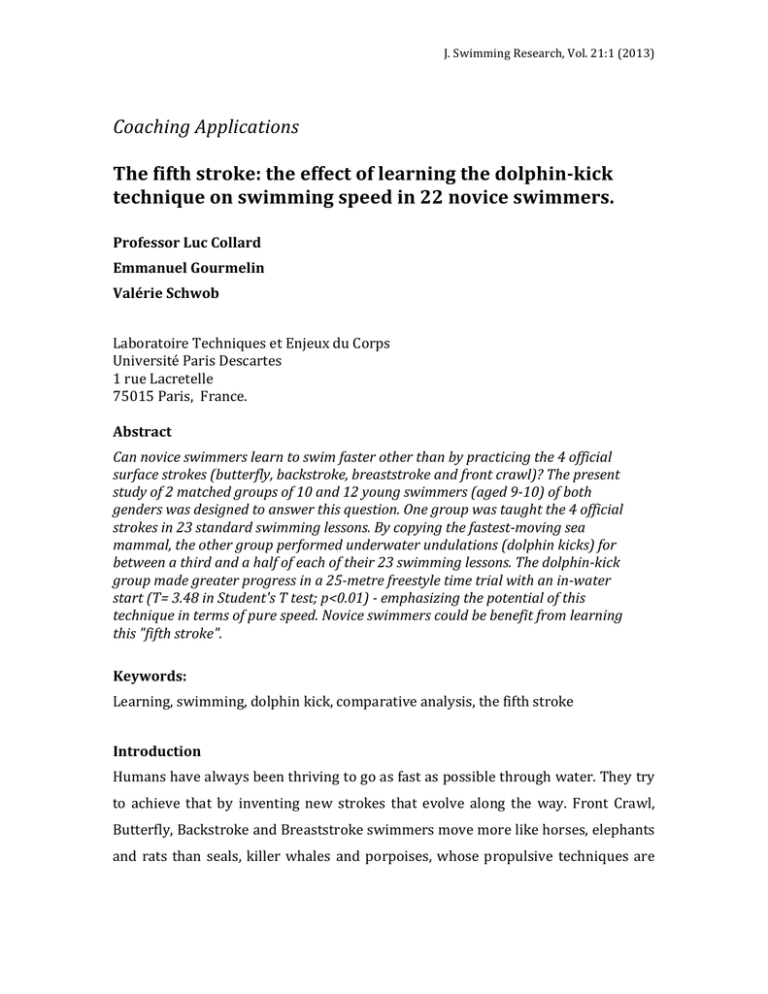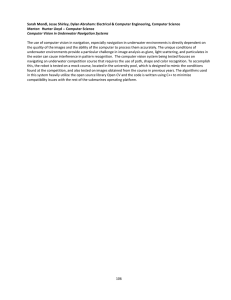Collard - Coaching Appl
advertisement

J. Swimming Research, Vol. 21:1 (2013) Coaching Applications The fifth stroke: the effect of learning the dolphin-­‐kick technique on swimming speed in 22 novice swimmers. Professor Luc Collard Emmanuel Gourmelin Valérie Schwob Laboratoire Techniques et Enjeux du Corps Université Paris Descartes 1 rue Lacretelle 75015 Paris, France. Abstract Can novice swimmers learn to swim faster other than by practicing the 4 official surface strokes (butterfly, backstroke, breaststroke and front crawl)? The present study of 2 matched groups of 10 and 12 young swimmers (aged 9-­‐10) of both genders was designed to answer this question. One group was taught the 4 official strokes in 23 standard swimming lessons. By copying the fastest-­‐moving sea mammal, the other group performed underwater undulations (dolphin kicks) for between a third and a half of each of their 23 swimming lessons. The dolphin-­‐kick group made greater progress in a 25-­‐metre freestyle time trial with an in-­‐water start (T= 3.48 in Student's T test; p<0.01) -­‐ emphasizing the potential of this technique in terms of pure speed. Novice swimmers could be benefit from learning this "fifth stroke". Keywords: Learning, swimming, dolphin kick, comparative analysis, the fifth stroke Introduction Humans have always been thriving to go as fast as possible through water. They try to achieve that by inventing new strokes that evolve along the way. Front Crawl, Butterfly, Backstroke and Breaststroke swimmers move more like horses, elephants and rats than seals, killer whales and porpoises, whose propulsive techniques are J. Swimming Research, Vol. 21:1 (2013) much more geared to speed (Fish, 1993, Sfakiotakis, Lane, Davies, 1999, Arellano et al. 2003, Rohr & Fish, 2004, Loebbecke et al. 2009). The former Olympic medallist David Berkoff started to incorporate the dolphin kick in his racing, and between 1984 and 1988, the American swimmer extended his dolphin-­‐kick distance from 15 to 35m, and his 100 m backstroke times fell accordingly. In 1988 FINA announced the rule change. The 15m limit on underwater swimming was imposed first on backstroke and then on butterfly (1996) and freestyle (2001). Other excellent underwater kickers demonstrate the potential of the dolphin kick: Michael Phelps' teammate Ryan Lochte, for example. During a training session in the summer of 2009, Lochte was caught "over the speed limit" by recording 20.8 seconds for 50 m underwater, with a single breath before the turn at 25 m. Although dolphin-­‐kicking is not at all natural, it is hardly more difficult and no more artificial than the Backstroke, Breaststroke, Butterfly or Front Crawl. This is the hypothesis which we set out to test in the present study. Compare two learning techniques: with and without dolphin kick. New approaches to swim teaching: learning to dolphin-­‐kick: In about two thirds of the cases, a child's first ever movements in water are based on "doggy paddle". The remaining third involve variants of breaststroke-­‐type scissor kicks, which are less efficient due to the resistance caused by bringing the knees forward after the scissor kick (Maillard, Pelayo, 2000)). Propulsion is mainly provided by synchronised leg pedalling and semi-­‐propulsive balancing with the arms (Catteau & Garoff, 1968, Pelayo et al. 1999). It is understandable that most novice swimmers first adopt a propulsive approach, with alternate leg movements and use of the arms to provide balance; the swimmers' initial reaction is to perform in the water as they do on land (Catteau, 2008). Undulations -­‐ the following adaptive step -­‐ are simply the aquatic equivalent of terrestrial leaping (Fish, 1996). The experimental protocol. J. Swimming Research, Vol. 21:1 (2013) We wanted to establish whether or not regular dolphin kick practice aids swimming performance. To this end, we took a group of novices with no fear of the water and who were capable of swimming time trials of over distances where speed is more important than endurance. In addition to the absolute speed over 25 m, we measured the distance swum underwater. Along with an "underwater group", we also studied a control group which was comparable in terms of swimming ability, gender, age and experience but was not given any training in the dolphin-­‐kick technique. The total absence of dolphin kicking in the control group was expected to highlight the effect of undulation in the underwater group. The control group followed a standard, 4-­‐stroke learning programme recommended by the French swimming federation and is referred to as the "surface group"1. Two groups of around fifteen children (aged 9-­‐10) participated in this longitudinal study. We decided to look at whether the two groups improved over 100 m after their respective training programmes After the time trials, each group underwent a specific training programme. The novice swimmers in the underwater group had to spend between a third and a half of each one-­‐hour session practicing undulation, whereas the novice swimmers in the surface group were taught a standard programme based on Front Crawl, Backstroke, Breaststroke and Butterfly. After 23 sessions, we used a post-­‐ intervention time trial (identical to the pre-­‐intervention time trial) to measure the progress produced by the swim training. The swimmers in the underwater group had swum 29% less distance in training than those in the surface group (44,150 m versus 61,800 m), on average. This was due to the fact that the repeated breath-­‐hold exercises in the underwater group (with 16,775 m swum underwater, i.e. 38% of the total distance swum) required longer phases of passive, stationary recovery and active recovery . Results. Greater progress over 25 m, thanks to the dolphin kick. J. Swimming Research, Vol. 21:1 (2013) It is noteworthy that the underwater group's improvement was significantly greater: after having spent a fair proportion of their time practising the dolphin kick, the children were able to swim faster. After learning, the underwater group swam further underwater and this new knowledge had an influence on their Freestyle speed over 25 (three quarters of which were swum at the surface). On the basis of the present results, we can state that the interspecific transfer in the underwater group was greater than the intraspecific transfer in the surface group. By focussing on learning the four strokes, the members of the surface group had indeed progressed in terms of their surface performance but less so than the swimmers having focused on underwater swimming during their lessons. Discussion : Advantage of learning the dolphin-­‐kick and a plea for a fifth official stroke Swimming is an artificially constructed system which deeply fashions the personality of its executors in given ways. It may be that underwater swimming techniques are the new "using" of swimming. They characterised a new dynamic, potentials for action. For the time being, swimmers (even novices) who swim outrageously far underwater are perhaps the discrete vectors of swimming's new replicators. To practice dolphin-­‐kick precociously allows the swimmer to use it in different techniques. It can probably help towards faster swimming. The acquisition of this skill enables swimmers to better understand both the different strokes and the different efficiency principles behind them.



